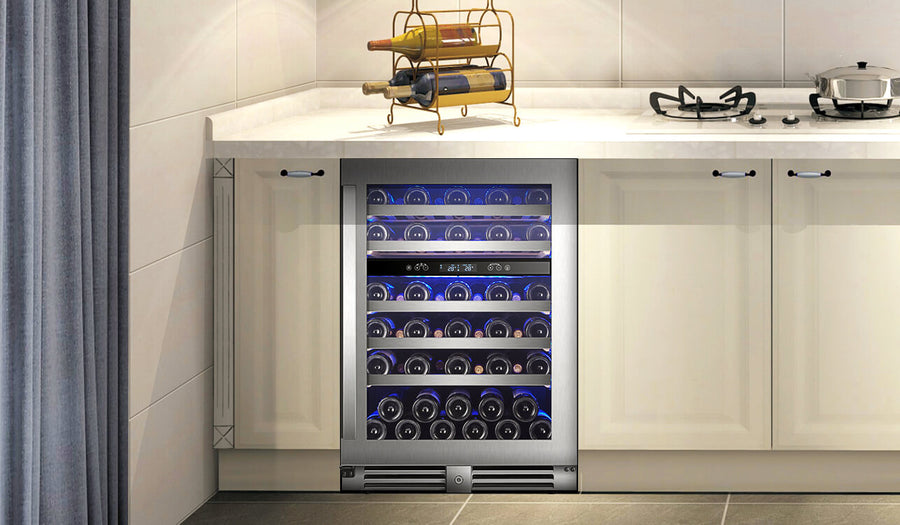The world of wine is often one of delicate balances and nuanced choices. One such debate that divides enthusiasts is whether to introduce ice into the sacred realm of the wine fridge. Is it a refreshing addition or a chilling compromise? Is it ever acceptable to let ice invade the sanctity of the wine fridge?
How Wine Fridges Work
Before we dive into the debate, it's essential to understand the inner workings of wine fridges. Unlike the standard refrigerator, a wine fridge is designed to maintain a specific temperature range optimal for storing wine. These specialized appliances are not merely coolers; they are guardians of temperature, ensuring wines age gracefully and reach their full potential. This range typically falls between 45°F and 65°F, ensuring wines age gracefully and retain their intended flavors.
Read more: What Temperature Should I Keep My Wine Refrigerator At?

Pros of Using Ice in a Wine Fridge
Quick Cooling Effect: One apparent advantage of adding ice to a wine fridge is the rapid cooling effect it imparts to your favorite bottle. This can be particularly enticing when you find yourself with an unexpectedly warm bottle and a desire for a chilled glass.
Cons of Using Ice in a Wine Fridge
Impact on Temperature Consistency: However, the seemingly innocent addition of ice may disrupt the delicate temperature consistency crucial for proper wine storage. Wine, being a delicate elixir, thrives in stability, and sudden temperature fluctuations can alter its aging process.
When It's Acceptable to Use Ice
In certain situations, using ice might be acceptable, even beneficial. For example, when hosting a gathering and needing to chill a bottle quickly, or when dealing with a wine that is intended to be served slightly cooler than the current storage temperature.
Alternatives to Using Ice
If the idea of ice in your wine fridge doesn't sit well with you, fear not. There are alternative methods to cool your wine without compromising its quality. Wine chillers, pre-chilled accessories, or even a short time in the refrigerator can achieve the desired temperature without the potential drawbacks of ice.
Read more: Wine Storage: Avoid These Common Mistakes When Storing Red Wine

Preserving Wine Integrity
Ultimately, the key is to preserve the integrity of the wine. Different wines have different optimal serving temperatures, and understanding these nuances can help you make informed decisions about chilling methods. Different wines have different temperature preferences. Reds, whites, and sparkling wines each have their ideal serving temperatures, and understanding these nuances is key to elevating your wine experience.
Let's explore the recommended temperatures for various wine varieties:
- Sparkling Wines: 40 °F (4 °C) to 50 °F (10 °C)
- White Wines and Rosés: 45 °F (7 °C) to 55 °F (13 °C)
- Red Wines: 55 °F (13 °C) to 65 °F (18 °C)
Conclusion
In the end, the choice to put ice in your wine fridge is a personal one. It hinges on your preferences, the type of wine you're dealing with, and the circumstances at hand. Whether you opt for a quick chill or prefer the slow dance of aging, let your choices enhance rather than compromise your wine experience.
FAQs
1. Does adding ice affect the aging of wine?
- A: Yes, ice can impact aging by introducing temperature fluctuations that may alter the wine's development.
2. Can you use ice in a wine fridge for red wine?
- A: While generally not recommended, a slight chill using ice may be acceptable for certain red wines in specific situations.
3. How quickly can ice cool down wine in a fridge?
- A: Ice can have a rapid cooling effect, but careful monitoring is crucial to avoid over-chilling.
4. Are there wines that benefit from using ice in the fridge?
- A: Lighter wines, like some whites and rosés, may benefit from a brief chill using ice, especially in warmer climates.
5. Can using ice in a wine fridge dilute the wine?
- A: Ice can cause slight dilution; however, the extent depends on the amount of ice and the duration of exposure.







